Dinosaur footprints in Connecticut and Massachusetts:Dinosaur footprints in the Connecticut River valley were first described in the mid 19th century, and originally were thought to be these of giant birds, because of the similarity in shape of the three-toed bird and dinosaur feet (except for the size). Footprints are given a genus and species name as if we knew for certain what animal made the footprints. In many cases we really are not certain which animal made the prints, and different-looking footprints may have been made by juveniles and adult of the same species. In addition, some prints were made by direct contact with the foot of the animal, and its digits and sometimes even skin made a clear inprint. In other cases ('undertrack') we see a much more vague outline, because the track was found a few layers below the physical imprint. The mudlayers deformed and bulged downward under the weight of the animal, leaving an ever vaguer outline in ever deeper layers of mud. |
|||
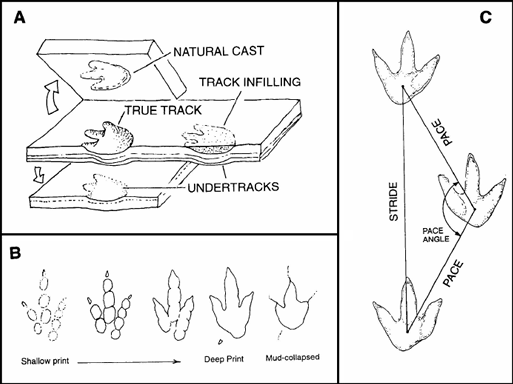 |
|||
| Eubrontes, Anchisauripus and Grallator tracks were all made by theropod dinosaurs (ranging in size from rather large to small), that means bipedal dinosaurs, probably predators. | |||
|
Grallatortracks (typically 2-6 inch, 5 to 15 cm) were first documented by Edward Hitchcock in 1858. Hitchcock collected numerous footprint specimens which are now in the Pratt Museum at Amherst College. |
|||
|
The three-toed Grallator prints are abundant and widely distributed, with several species named, including G.cursorius, G. parallelus and G. tenuis. Grallator tracks may have been made by small theropod dinosaurs such as Coelophysis (maybe up to 3-4 feet tall). Edward Hitchcock gave the name Grallator to tracks bearing a close relationship with water birds of the family Grallae. To quote Htchcock: Other tracks exhibit two phalanges on the inner toe, three on the middle, and four on the outer...as in the feet of living birds.' Grallator tracks are narrow and elongate, and trackways are also extremely narrow with long steps. Such a pattern indicates a fast-moving and erect animal, and prompted Hitchcock to name one species Grallator cursorius, indicating a running ability. Anchisauripus ('Anchisaurus foot'), was first described by Richard Swann Lull in 1904 as the probable track of the prosauropod dinosaur Anchisaurus ('near reptile'). Specialists now believe that Anchisauripus tracks were made by a theropod dinosaur, as were those of Grallator. Indeed, it is possible that Anchisauripus tracks (typically 6-10 inch, 15 to 25 cm) are the footprints of large individuals of the Grallator trackmaker (estimated height about 6 feet). It has also been suggested that Grallator tracks may have been made by juvenile Eubrontes makers. When we compare the two, however, we find that one is not just a scaled-up version of its smaller contemporary, it is proportionally much wider, the width being 65 percent of the length in Eubrontes, as compared with 42 percent for Grallator. Some say that as animals get bigger they generally grow wider at a faster rate than they grow narrower (allomteric growth), so that Eubrontes could be the spoor of an adult of the species that made Grallator tracks. But we often find lots of small Grallator, a few large Eubrontes, and nothing in between, and if they were all growing up together we would expect many intermediate sizes (unless their absence reflects the spocial structure of the animals). |
|||
 |
|||
| Figure in Olsen, P. E., McDonald, N. G., Huber, P., and Cornet, B., 1992. Stratigraphy and paleoecology of the Deerfield Rift Basin (Triassic-Jurassic, Newark Supergroup), Massachusetts. Guidebook for Fieldtrips in the Connecticut Valley region of Massachusetts and adjacent states, 84th Annual Meeting NEIGC, Contribution nr 66, Dept. of Geology, University of Massachusetts, 488-535 | |||
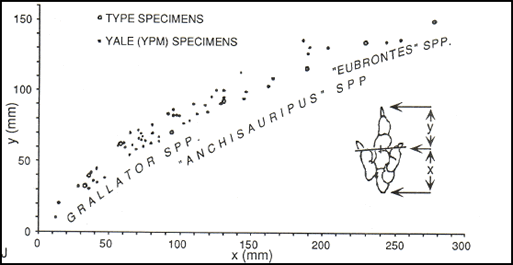 |
|||
|
The Eubrontes tracks (typically 14-16 inch, 35-40 cm long), first described by Edward Hitchcock in 1847, may have been made by Dilophosaurus, a predatory dinosaur whose size and stride closely match the Eubrontes prints, but no Dilophosaurus skeletal remains have been found in the Connecticut River Valley. Edward Hitchcock said the following: 'I threw (the foot print) out at first because I could not believe that an impression three to four times larger than that of the great African ostrich's foot could be a track. For a time, I regarded it as the giant ruler of the valley'. An even larger track is Otozoum moodii, first described by Edward Hitchcock in 1847. It was probably made by a large prosauropod dinosaur, most likely one of the types found in the Newark Supergroup, or by an ankylosaur (armored dinosaur), or a phytosaur (large, crocodile-like animal). |
|||
|
The Triassic Jurassic Footprint Project has made the old publications by Hitchock, Lull and others electonically available at The Connecticut Valley Virtual Ichnological Library, |
|||
 |
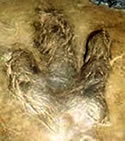 |
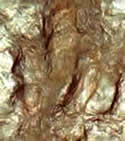 |
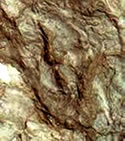 |
| Otozoum ('giant animal') moodii | Eubrontes ('true thunder')giganteus ; Connecticut state fossil | Anchisauripus | Grallator |